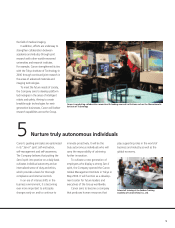Canon 2006 Annual Report Download - page 20
Download and view the complete annual report
Please find page 20 of the 2006 Canon annual report below. You can navigate through the pages in the report by either clicking on the pages listed below, or by using the keyword search tool below to find specific information within the annual report.
18
PRODUCTION
As a further step toward production reform, Canon is aiming to reduce its
cost-to-sales ratio to 45% in 2010.
Toward the Establishment of New
Production Methods
The introduction of the cell production system, which
replaced conveyor belt lines with small teams of
workers, or “cells,” who assemble products from start
to finish, marked a major step forward in production
reforms at Canon. With ingenuity, effort, and the
experience-based knowledge of each individual worker
as driving forces, cell production is employed at all of
Canon’s production bases worldwide. Cell production
supports just-in-time production—the manufacture of
products only when and in the amounts needed—
while also enabling highly accurate supply chain
management (SCM) in response to market demands.
As a next step to further production reform, the
Company is boosting in-house production, establishing
automated production systems and reforming its
procurement operations. Canon has targeted a cost-
to-sales ratio of 45% for 2010.
In-House Production and Procurement
Innovations
The in-house production of key parts and components
as well as production equipment represents one of
Canon’s most important efforts to increase
competitiveness and reduce costs. As an example of
the Company’s endeavors, Canon made Igari Mold
Co., Ltd. a wholly owned subsidiary in 2004 to
increase in-house mold production. Mold-making
operations across the entire Group were consolidated
into this manufacturer of precision plastic molds, which
was renamed Canon Mold Co., Ltd. in January 2007.
In the area of procurement innovations, Canon is
carrying out sweeping structural reforms of its current
system while consolidating suppliers. In addition, the
Company is improving collaboration between procure-
ment and development divisions in order to reduce the
cost of parts, beginning at the development stage.
Building Integrated Production Systems and
Increasing Production Capacity
In order to further reduce lead times, Canon is building a
production system for fully integrating the manufacture
of materials and key components, as well as assembly
and logistics operations. For example, construction of a
new lens plant at Oita Canon Inc. has been completed
and operations will begin in spring 2007, enabling the
integration of interchangeable SLR camera lens produc-
tion with camera manufacturing operations.
At the same time, the Company is stepping up
production capacity in order to meet growing
demand. Oita Canon Materials Inc. completed
construction of a new toner and toner cartridge
facility in 2006, and has begun construction of
Producing color LBPs
and copying machines
through the cell production
system at Canon (Suzhou)
Inc. in China
Manufacturing high-precision molds at Canon Mold Co., Ltd. to
bolster in-house production and product competitiveness
























